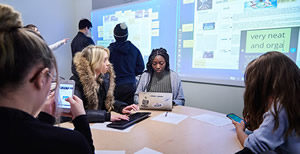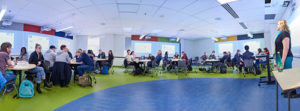At Dawson College in Montreal, Canada, there are three active-learning classrooms that the college calls “smart classrooms.” These rooms are designed with group tables and interactive whiteboards around the perimeter of the room. Two of the rooms have SMART Board technology while the third, and newest, has eight Nureva Walls that stretch around the room, providing 56 feet of digital workspace. It is the largest installation of Nureva visual collaboration solutions in a single classroom.
eCampus News spoke with Chris Whittaker, physics professor and coordinator of Dawson’s smart classrooms, about active learning and what goes on in a smart classroom.
Q: Please describe a smart classroom.
In these classrooms, students come together in a shared space to construct, manipulate, and negotiate meaning around a canvas. The environments become immersive—learning happens on walls, desks, tables, and in conversations. The interactive surfaces become shared perceptual spaces where students discuss meaning and clarity and come to a collective understanding.
When you are in an environment with touch screens dedicated to creating opportunities for shared perceptual meaning, you can dig down and construct knowledge in a deeper way.
Q: Do active-learning classrooms require technology?
If you want students exchanging, collaborating, and talking synchronously in class, then shared public spaces should be the primary focus of work. If students are working on a publicly displayed shared artifact, then they have to negotiate what goes in to it, how it’s represented, and so on. The process of negotiation is important, and if they are working solely through personal devices the process works differently. In our newest room, the one with Nureva Span Wall technology, personal devices become a complement to the shared spaces in that students can contribute to the assembly of an artifact, but the process of negotiation stays focused on the shared public space of the walls around the perimeter of the room.
Q: What do products like the Nureva visual collaboration solution allow you do?
Technology needs to serve good pedagogy; by itself it’s just tech. One of the things I like about the Nureva Wall and other interactive edtech products is that they can become powerful pedagogical tools if design is carefully considered. We have adopted a design cycle behind our classrooms, the technology in them, and the pedagogical strategies we use that allows faculty to collaborate with researchers and other practitioners to develop effective uses of the tech.
Q: How are your instructors promoting active learning?
The Nureva room is a particularly good room for assembling larger artifacts that can persist over several classes, a semester, or years (in the case of student portfolios). We work on span documents that live in the cloud and are up to 200 feet long and 4 feet high. We put links, documents, words, web pages, and images into them.
One of our professors was exploring community gardens and sustainability. Her class worked on different spaces within the same canvas (i.e., document). She assigned each group a neighborhood and they used their phones or other devices to research community gardens, recycling, etc., and populated the canvas with information about their community. Once the information was assembled, students processed and rearranged that information within their groups. Now they’ve assembled, processed, and augmented their collective artifact. Next, the teacher invited the groups to swipe left or right to see other group’s works within the same canvas. She asked them to create a part of the canvas to collect all the commonalities. Students again worked on their own devices to access other group’s information, find commonalities and differences, and form conversations around artifacts.
For this class, the canvas became a semester-long showcase and analysis of Montreal community gardens and sustainability plans. The professor was able to leverage each group’s work as well as work between groups. Students could move around the entire room and discuss the artifacts as they scrolled through the canvas.
It’s a brilliant way to get students to work at all levels of Bloom’s taxonomy, and since it’s a cloud document, it’s accessible anywhere.
In another class, students created plot lines for historical films. They placed images from events into a timeline, which is another smart use of the space. These types of rooms let you become emotionally as well as physically involved.
One more example. A photography student used the Nureva room to showcase three year’s worth of photos for his final exhibit. He uploaded his work into a canvas that included 360-degree panorama pictures. People could scroll through pictures and within pictures and experience a continuous canvas that spanned three years of his brilliant work.
Q: How do students like active learning and smart classrooms?
One of the great things about these high-tech learning environments is that students see how other people think. They create formalized external explanations of what’s in their brain, and students say thing like, ‘I hadn’t thought about it from that perspective. That’s cool!’ and ‘I get to see how other students think.’
To see someone else as they’re representing information through a sketch, paragraph, or image is a great way to learn. These technologies also allow us to reduce the risk people take when they contribute to something. People feel more comfortable redrawing or erasing something because they can get it all back—all versions are saved in the cloud.
Q: Where can people interested in active learning get more information?
You can find out more at SALTISE (Supporting Active Learning & Technological Innovation in Studies of Education, a Montreal-area learning community that fosters the development and research of tools and resources for pedagogical innovations. For active learning activities tailored to specific learning outcomes and content, check out Active Learning Activities.
- 4 lessons learned from a successful badging initiative - May 23, 2019
- 6 tips for reaching adult students - May 20, 2019
- How can higher-ed better prepare students to enter the workforce? - April 29, 2019


